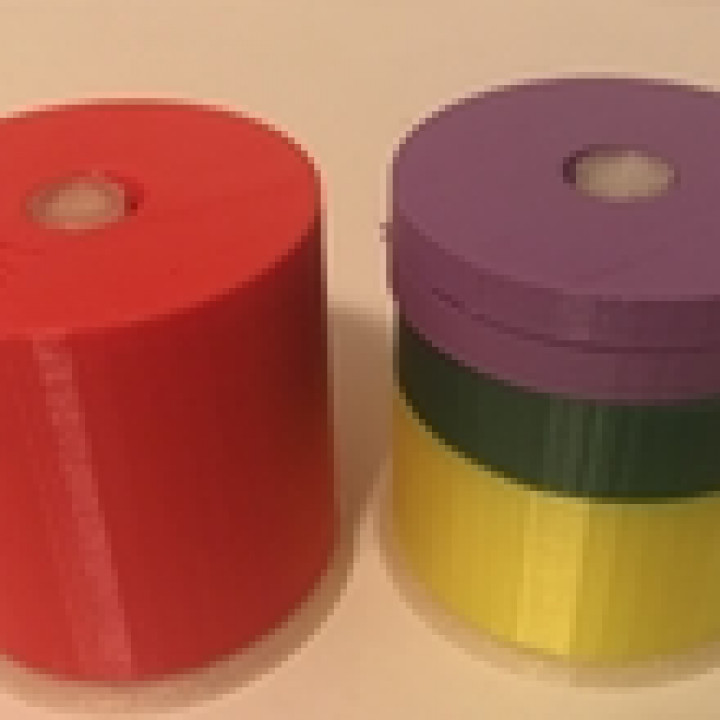
Visualizing Fractions Lesson Plan
myminifactory
Here's a design and lesson plan that my wife and I created together. It's an educational manipulative meant to facilitate the introduction of fractions to students. Below is a copy of the lesson plan text. The PDF version includes figures/pictures. ------------------------------------------------- Visualizing Fractions Lesson Plan Subject: Mathematics Grade: 3 Topic: Fractions Goals: Understand two fractions as equivalent (equal) if they are the same size, or the same point on a number line. Standard: California CCSS 3.NF.A.1 http://caccssm.cmpso.org/fractions/fractions-resources-by-standard Develop understanding of fractions as numbers. 1. Understand a fraction 1/b as the quantity formed by 1 part when a whole is partitioned into b equal parts; understand a fraction a/b as the quantity formed by a parts of size 1/b. Objectives: Given the Visualizing Fractions Manipulative (VFM), students should be able to see that fractions when combined equal a whole by stacking fractions on the Visualizing Fractions spindle and comparing it to the whole unit. Introduction: A VFM [Figure 1] should be passed out to each student, or one VFM can be given to two students. Students should be invited to explore the VFM and take the one whole VFM unit and place it on the Visualizing Fractions spindle. Development: Instructor will explain that the one-unit piece can represent anything that is one thing but can be divided, like an apple, a pizza, a piece of clay, etc. The instructor may ask the children to share things that are a whole but can be divided. Invite the children to think of the one-unit piece as a representational object if that helps them better visualize the concept of fractions. Instructor will then show that when stacked the two ½ pieces equal a whole [Figure 2]. The instructor can explain that this is like cutting a sandwich in half – when you put the two pieces together, you have the whole sandwich. Practice: Students should be asked to take other VFM pieces and construct fractions equal to the one-unit piece on the Visualizing Fractions spindle. If working in pairs, students should take turns so each child has a chance to construct a whole unit from the fraction pieces. Students should take the 1/3, ¼, 1/6, and 1/8 fraction pieces and construct on the spindle equaling a whole. Note – some students may determine that different combinations of the fraction pieces can equal a whole, such as one 1/3 piece and two 1/6 pieces. If the instructor sees this, confirm the student's finding and point out that this means two 1/6 pieces equals the same as one 1/3. If a student combines a variety of fractions to make something slightly more or less than equaling one unit, such as two ¼, one 1/3, and one 1/8, encourage the student to look closely to see if the unit is exactly the same size as the one-unit piece. Check for Understanding: Instructor should walk from student to student as they use the VFM. The instructor may encourage students to keep their fraction pieces in place so they can quickly confirm understanding and help correct students who are struggling. Closure: Review that fractions, when put together, can equal a whole. Ask students for findings. Some may note that when the upper number (numerator) and lower number (denominator) equal one another, it makes a whole. Others may note that different fractions equal other fractions (such as two 1/8 pieces equaling 1/4) [Figure 3]. The overall message to be reiterated is that when fractions are put together and are the same size they are equal. Bonus: For those excelling in the lesson plan, the teacher may wish to introduce the expanded Visualizing Fractions Manipulative (xVFM). The xVFM set includes divisions of each fraction piece into smaller wedges. The smallest piece being 1/8 of 1/8 or 1/64 [Figure 4]. Printing Tips: 30% infill at 50 mm/s If you wish to design your own fraction piece, you’ll need to know the size of a whole. One whole piece is 50mm tall with a diameter of 50mm and an inner diameter of 12.5mm. With those measurements, you should be able to recreate any fraction size.
With this file you will be able to print Visualizing Fractions Lesson Plan with your 3D printer. Click on the button and save the file on your computer to work, edit or customize your design. You can also find more 3D designs for printers on Visualizing Fractions Lesson Plan.
